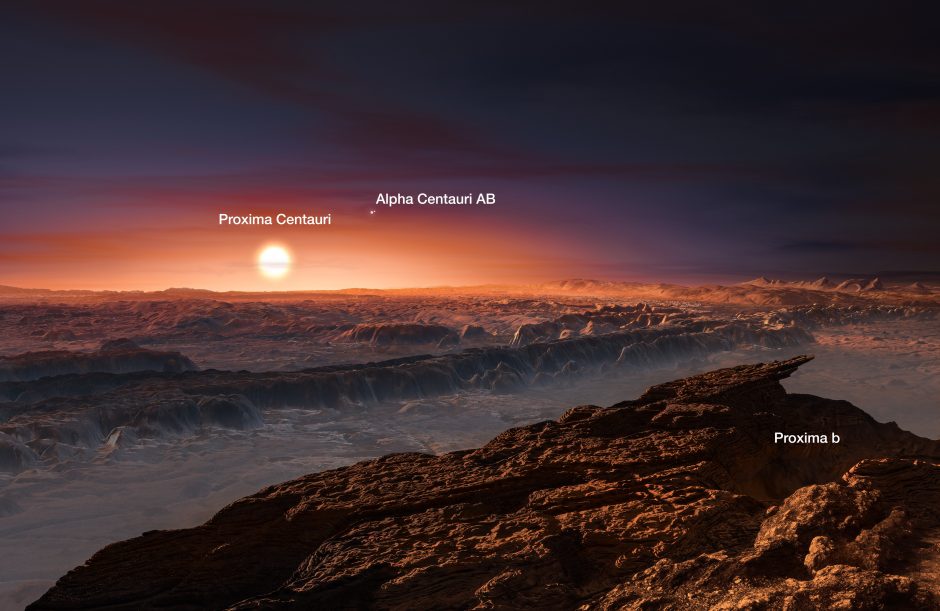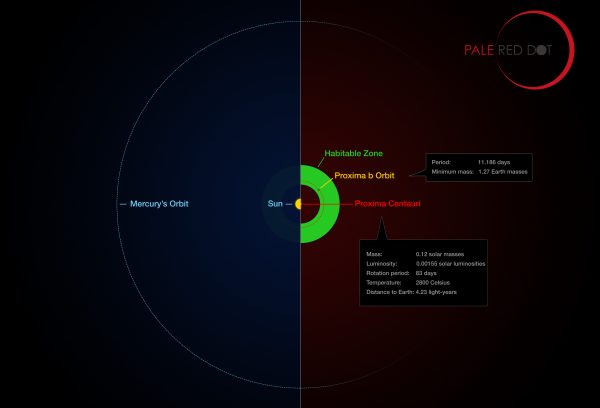Earth twin planet found in the habitable zone of the nearest star to the sun.

A team of astronomers has discovered a planet similar to Earth orbiting Proxima Centauri in just over 11 days. This planet is at a distance from its star that would allow water to remain in its liquid state.

This artist’s impression shows a view of the surface of the planet Proxima b orbiting the red dwarf star Proxima Centauri, the closest star to the Solar System. The double star Alpha Centauri AB also appears in the image (Credit ESO).
Proxima Centauri is a red dwarf located 4 light years from Earth and is one of the best studied of low mass stars. Guillem Anglada-Escude and colleagues initially analyzed measurements from HARPS and UVES between 2000 and 2014. In spite of unconvincing results they had acquired the certainty that “something” existed around Proxima. “The results obtained with the same amount of points spread over a year or over a few weeks are completely different,” says Christophe Lovis, an astronomer and member of NCCR PlanetS, “the activity of the star can mislead us if the measurements are too far apart. ” The team of astronomers decided to get much closer points and convinced ESO to make a measurement of Proxima every night for 3 months.
“The resulting signal is this time clear and convincing”, says Christophe Lovis, “and we are not completely unrelated to this discovery, because the authors used HARPS, an instrument and reduction software developed at the Geneva Observatory. ” This software however had to be adapted to measure red dwarfs since it was designed for bright stars whose spectrum is less rich in lines.

This infographic compares the orbit of the planet around Proxima Centauri (Proxima b) with the same region of the Solar System. Proxima Centauri is smaller and cooler than the Sun and the planet orbits much closer to its star than Mercury (Credit ESO).
Such discovery of a planet of 1.3 Earth masses in the habitable zone of the nearest star to the Sun will raise enthusiasm. “The conditions are such that the water can be liquid, but nothing is yet certain” ensures Christophe Lovis, there are many chances that the planet is synchronized with its star, i.e. it shows it always has the same face. It is therefore likely that it has a hot side and a cold side.
Simulations made by ESO show that in the case of synchronous rotation temperature of the planet with an Earth like atmosphere could reach 40 degrees on a sunny side and -60 degrees to the face in the shade.
Moreover, like all M stars, Proxima emits strongly in X-rays, and although its total brightness is only 0.17% of that of the Sun it shines like it in the X domain. Located at 5% of the Earth-Sun distance from its star, Proxima b receives 400 times more X rays than Earth. This bombardment would be hardly compatible with the emergence of life, unless the planet has a protective atmosphere. “It is possible,” says Christophe Lovis, “this planet being more massive than Earth, it can maintain an atmosphere even if the radiation from the star would tend to blow it. One can imagine a mechanism that feeds the atmosphere, a kind of surface degassing. ” A mechanism that would maintain sufficient density to the atmosphere to protect the surface of the planet from dangerous radiation.
That atmosphere, if any, would be difficult to detect. One imagined way would be to visually separate the planet from its star with an instrument such as SPHERE for example, then take the spectra of the two objects. That of the planet will inevitably be mixed with that of the star but slightly shifted in wavelength because of its movement around the star. So the star’s spectrum could be subtracted to that of the planet to obtain the spectrum of the planet only. This technique would identify chemical elements in the atmosphere. “This method is at the edge of the instrumentation,” says Christophe Lovis, “it is one of the reasons why the E-ELT will be built.”
Categories: News
